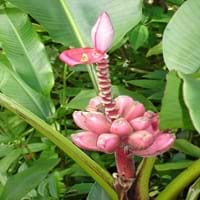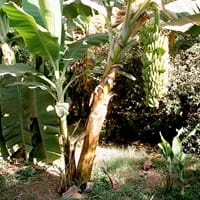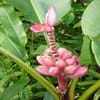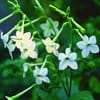Life Span
Perennial
Annual
Type
Tender Perennial
Tender Perennial
Origin
India
Hybrid origin
Types
Scarlet banana, Fe'i bananas
Flowering Plants, Fruits, Herbs
Number of Varieties
Not Available
Habitat
tropical environments, Tropical regions
Subtropical climates, Tropical rainforest, Tropical regions
USDA Hardiness Zone
7-10
8-15
AHS Heat Zone
Not Available
Not Available
Sunset Zone
H1, H2, 11, 12, 13, 14, 15, 16, 17, 18, 19, 20, 21, 22, 23, 24
H1, H2, 14, 15, 16, 17, 18, 19, 20, 21, 22, 23, 24
Habit
Clump-Forming
Clump-Forming
Flower Color
White, Yellow, Violet
White, Yellow, Purple, Brown
Flower Color Modifier
Bicolor
Bicolor
Fruit Color
Pink, Violet
Green, Light Green
Leaf Color in Spring
Green
Green
Leaf Color in Summer
Green, Dark Green
Green
Leaf Color in Fall
Dark Green
Green
Leaf Color in Winter
Light Green
Light Green
Leaf Shape
Arrowhead
Oblanceolate , Ovate
Plant Season
Spring, Summer, Fall, Winter
Spring, Summer, Fall, Winter
Sunlight
Full Sun, Partial Sun
Full Sun, Partial Sun
Type of Soil
Clay, Loam, Sand, Well drained
Loam, Sand
The pH of Soil
Acidic, Neutral
Acidic, Neutral, Alkaline
Soil Drainage
Well drained
Average
Bloom Time
Indeterminate
Indeterminate
Tolerances
Drought
Drought
Where to Plant?
Ground
Container, Ground
How to Plant?
Seedlings, Transplanting
Divison
Plant Maintenance
Medium
Medium
Watering Requirements
Needs watering once a week, occasional watering once established, Requires watering in the growing season
Water every two or three days during warmer months
In Summer
Lots of watering
Lots of watering
In Spring
Moderate
Moderate
In Winter
Average Water
Average Water
Soil pH
Acidic, Neutral
Acidic, Neutral, Alkaline
Soil Type
Clay, Loam, Sand
Loam, Sand
Soil Drainage Capacity
Well drained
Average
Sun Exposure
Full Sun, Partial Sun
Full Sun, Partial Sun
Pruning
Remove damaged leaves, Remove dead branches, Remove dead leaves
Remove damaged leaves, Remove dead branches, Remove dead leaves
Fertilizers
Apply 8-10-8 amounts
All-Purpose Liquid Fertilizer
Pests and Diseases
Red blotch
Red blotch
Plant Tolerance
Drought
Drought
Flower Petal Number
Single
Not Available
Foliage Texture
Bold
Bold
Foliage Sheen
Glossy
Glossy
Attracts
Insects, Spider Mites
Insects
Allergy
Itchiness, Rash
Anaphylaxis
Aesthetic Uses
Not Used For Aesthetic Purpose
Not Available
Beauty Benefits
Good for skin, Skin cleanser
Not Available
Environmental Uses
Air purification, Food for birds
Air purification
Medicinal Uses
Heals minor burns
anti-cancer, Asthma, Diarrhea, Improve heart health, increase memory, lowering blood pressure, Potassium
Part of Plant Used
Fruits, Root
Flowers, Fruits, Leaves, Root, Sap
Other Uses
Used As Food, Used as Ornamental plant, Used for its medicinal properties, Used in salads
Animal Feed, Fine spines and trichomes are used as fiber for weaving, Leaves used for wrapping food, Pulp can be used to make rope place mats and other goods
Used As Indoor Plant
No
No
Used As Outdoor Plant
Yes
Yes
Garden Design
Bedding Plant, Container, Feature Plant, Foundation, Mixed Border, Tropical
Edible, Fruit / Fruit Tree, Mixed Border, Screening / Wind Break, Tropical
Botanical Name
MUSA velutina
Musa acuminata × Musa balbisiana
Common Name
Banana, Hairy Banana, Pink Banana
Banana, Hybrid Banana, Saba Banana
In Hindi
गुलाबी केले
Saba kela
In German
rosa Banana
saba Banane
In French
rose Banana
saba banane
In Spanish
Pink plátano
saba plátano
In Greek
ροζ Μπανάνα
saba banana
In Portuguese
Banana -de-rosa
saba de banana
In Polish
różowy Banana
saba banana
In Latin
Pink Banana
Saba Musa sapientum fixa
Phylum
Vascular plant
Magnoliophyta
Class
Liliopsida
Liliopsida
Order
Zingiberales
Zingiberales
Clade
Angiosperms, Commelinids, Monocots
Not Available
Tribe
Not Available
Not Available
Subfamily
Not Available
Not Available
Season and Care of Pink Banana and Saba Banana
Season and care of Pink Banana and Saba Banana is important to know. While considering everything about Pink Banana and Saba Banana Care, growing season is an essential factor. Pink Banana season is Spring, Summer, Fall and Winter and Saba Banana season is Spring, Summer, Fall and Winter. The type of soil for Pink Banana is Clay, Loam, Sand, Well drained and for Saba Banana is Loam, Sand while the PH of soil for Pink Banana is Acidic, Neutral and for Saba Banana is Acidic, Neutral, Alkaline.
Pink Banana and Saba Banana Physical Information
Pink Banana and Saba Banana physical information is very important for comparison. Pink Banana height is 365.76 cm and width 243.84 cm whereas Saba Banana height is 460.00 cm and width 370.00 cm. The color specification of Pink Banana and Saba Banana are as follows:
Pink Banana flower color: White, Yellow and Violet
Pink Banana leaf color: Green
Saba Banana flower color: White, Yellow, Purple and Brown
- Saba Banana leaf color: Green
Care of Pink Banana and Saba Banana
Care of Pink Banana and Saba Banana include pruning, fertilizers, watering etc. Pink Banana pruning is done Remove damaged leaves, Remove dead branches and Remove dead leaves and Saba Banana pruning is done Remove damaged leaves, Remove dead branches and Remove dead leaves. In summer Pink Banana needs Lots of watering and in winter, it needs Average Water. Whereas, in summer Saba Banana needs Lots of watering and in winter, it needs Average Water.





